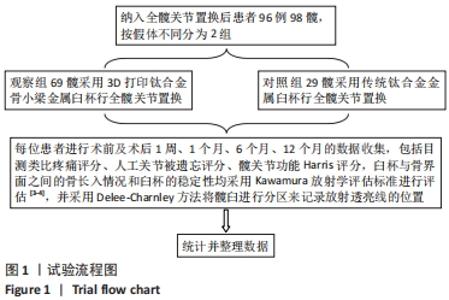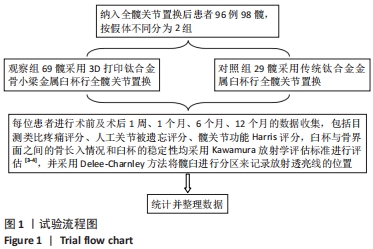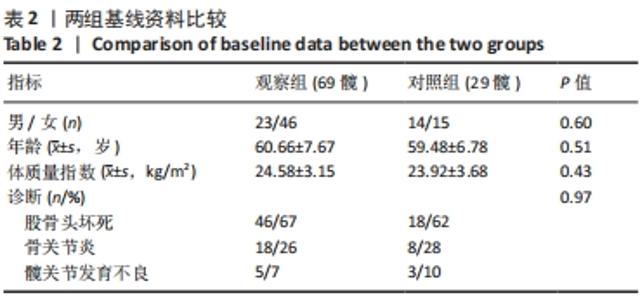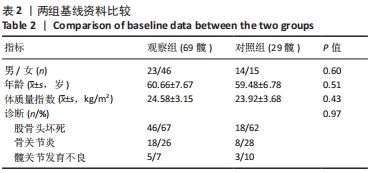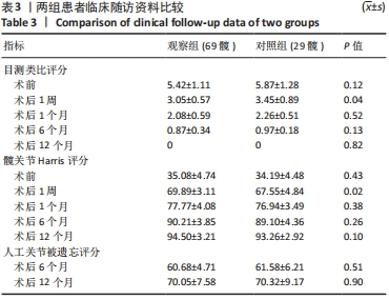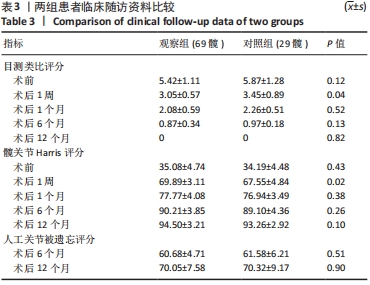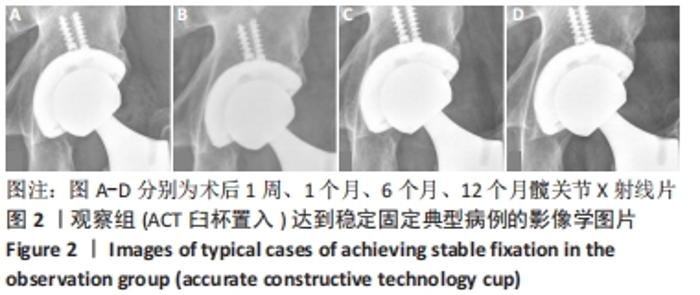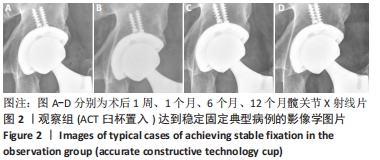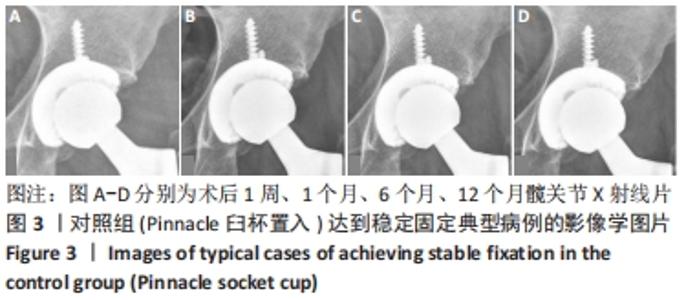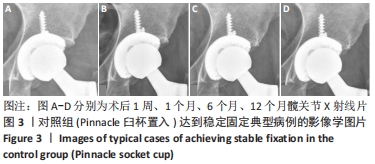[1] 孙祥燚, 张雷, 周利武, 等. 全髋关节置换术治疗成年双侧髋关节发育不良的短期疗效[J]. 实用骨科杂志,2018,24(8):687-691.
[2] 王法佳, 王华. 人工全髋关节置换术研究现状与展望[J]. 北华大学学报(自然科学版),2017,18(5):620-625.
[3] TANZER M, GRAVES SE, PENG A, et al. Is Cemented or Cementless Femoral Stem Fixation More Durable in Patients Older Than 75 Years of Age? A Comparison of the Best-performing Stems. Clin Orthop Relat Res. 2018;476(7):1428-1437.
[4] 王俏杰, 张先龙. 人工髋关节置换术的现状与热点[J]. 中华关节外科杂志(电子版),2015,9(6):718-724.
[5] 王晖, 张亚洲, 时莉芳. 骨小梁结构髋臼杯和实体结构髋臼杯的三维模型仿真分析[J]. 中国组织工程研究,2020,24(3):390-394.
[6] 高万露, 汪小海. 视觉模拟疼痛评分研究的进展[J]. 医学研究杂志, 2013,42(12):144-146.
[7] BEHREND H, GIESINGER K, GIESINGER JM, et al. The “forgotten joint” as the ultimate goal in joint arthroplasty: validation of a new patient-reported outcome measure. J Arthroplasty. 2012;27(3):430-436.
[8] HAROLD RE, BUTLER BA, DELAGRAMMATICAS D, et al. Patient-Reported Outcomes Measurement Information System Correlates With Modified Harris Hip Score in Total Hip Arthroplasty. Orthopedics. 2021;44(1):e19-e25.
[9] KAWAMURA H, BOURNE RB, DUNBAR MJ, et al. Polyethylene wear of the porous-coated anatomic total hip arthroplasty with an average 11-year follow-up. J Arthroplasty. 2001;16(8):116-121.
[10] DELEE JG, CHARNLEY J. Radiological demarcation of cemented sockets in total hip replacement. Clin Orthop Relat Res. 1976;(121):20-32.
[11] PRICE AJ, ALVAND A, TROELSEN A, et al. Knee replacement. Lancet. 2018;392(10158):1672-1682.
[12] MARADIT KREMERS H, LARSON DR, CROWSON CS, et al. Prevalence of Total Hip and Knee Replacement in the United States. J Bone Joint Surg Am. 2015;97(17):1386-1397.
[13] 边焱焱, 程开源, 常晓, 等. 2011至2019年中国人工髋膝关节置换手术量的初步统计与分析[J]. 中华骨科杂志,2020,40(21):1453-1460.
[14] 裴福兴, 康鹏德, 石小军. 全髋关节翻修术的相关问题[J]. 中华关节外科杂志(电子版),2013,7(5):588-590.
[15] 黄敬叶, 罗世兴. 骨水泥型与非骨水泥型髋关节置换的研究进展[J]. 医学综述,2017,23(11):2186-2189.
[16] 阿卜杜克热木·热夏提, 任姜栋, 阿斯哈尔江·买买提依明, 等. 保留髋臼杯骨水泥聚乙烯内衬置换的髋臼侧翻修[J]. 中国组织工程研究,2016,20(13):1866-1872.
[17] 程文俊, 王俊文, 焦竞, 等. 3D打印钛合金骨小梁金属臼杯在初次全髋关节置换术应用的临床和影像学评估:5年临床随访[J]. 中华创伤骨科杂志,2018,20(12):1066-1071.
[18] AFFATATO S, RUGGIERO A, JABER SA, et al. Wear Behaviours and Oxidation Effects on Different UHMWPE Acetabular Cups Using a Hip Joint Simulator. Materials (Basel, Switzerland). 2018;11(3):433.
[19] 黄浩. 生物型髋臼杯早期无菌性松动的相关危险因素分析[D]. 南宁:广西医科大学,2018.
[20] 郝永强, 王磊, 姜闻博, 等. 3D打印髋关节假体为复杂髋臼骨缺损翻修全髋关节置换术提供精准重建、稳定固定和功能恢复[J]. Engineering. 2020;6(11):174-185.
[21] MELANCON D, BAGHERI ZS, JOHNSTON RB, et al. Mechanical characterization of structurally porous biomaterials built via additive manufacturing: experiments, predictive models, and design maps for load-bearing bone replacement implants. Acta Biomater. 2017;63:350-368
[22] 徐卫东, 袁恒锋, 陈康尧, 等. 金属骨小梁杯在髋臼翻修中的应用及随访[J]. 中华关节外科杂志(电子版),2009,3(5):552-557.
[23] 商广前, 项帅, 张鹏军, 等. 3D打印骨小梁金属臼杯用于全髋关节置换翻修术的效果[J]. 中华创伤杂志,2021,37(7):628-634.
[24] 胡如印. 3D打印多孔钛金属骨小梁髋臼杯的临床应用、体内基础研究与生物力学研究[D]. 南宁:广西医科大学,2018.
[25] 李晓宇, 宋超伟, 费琦, 等. 骨修复3D打印钛合金支架材料的研究进展[J]. 临床和实验医学杂志,2019,18(2):222-225.
[26] LUAN H, WANG L, REN W, et al. The effect of pore size and porosity of Ti6Al4V scaffolds on MC3T3-E1 cells and tissue in rabbits. Sci China Technol Sci. 2019;62(7):1160-1168.
[27] 王姗姗, 王伟, 李岩, 等. 3D打印钛合金骨小梁金属臼杯全髋关节置换术的短期疗效[J]. 中华肿瘤防治杂志,2016,23(S1):204-205.
[28] 张桢, 左昌俊. 加速康复外科理念的围术期护理对人工全髋关节置换术患者术后快速康复的影响[J]. 中国药物与临床,2021,21(20): 3487-3489.
[29] MARTIN O, JOHANNES G, JAN M, et al. Association of patient satisfaction with the Oxford Hip Score and the Forgotten Joint Score after total hip arthroplasty. Swiss Med Weekly. 2015;145:38S.
[30] PULIERO B, BLAKENEY WG, BEAULIEU Y, et al. Joint Perception After Total Hip Arthroplasty and the Forgotten Joint. J Arthroplasty. 2019; 34(1):65-70.
[31] GALEA VP, INGELSRUD LH, FLORISSI I, et al. Patient-acceptable symptom state for the Oxford Hip Score and Forgotten Joint Score at 3 months, 1 year, and 2 years following total hip arthroplasty: a registry-based study of 597 cases. Acta Orthop. 2020;91(4):372-377.
[32] ROBINSON PG, MACDONALD DJ, MACPHERSON GJ, et al. Changes and thresholds in the Forgotten Joint Score after total hip arthroplasty: minimal clinically important difference, minimal important and detectable changes, and patient-acceptable symptom state. Bone Joint J. 2021;103-B(12):1759-1765.
[33] MANIAR RN, DHIMAN A, MANIAR PR, et al. Forgotten Joint Score Post Total Knee Arthroplasty and Its Correlation with the New Knee Society Score. Indian J Orthop. 2021;55(5):1175-1179.
[34] SINGH V, ZAK S, SCHWARZKOPF R, et al. Forgotten Joint Score in THA: Comparing the Direct Anterior Approach to Posterior Approach. J Arthroplasty. 2020;35(9):2513-2517.
|
